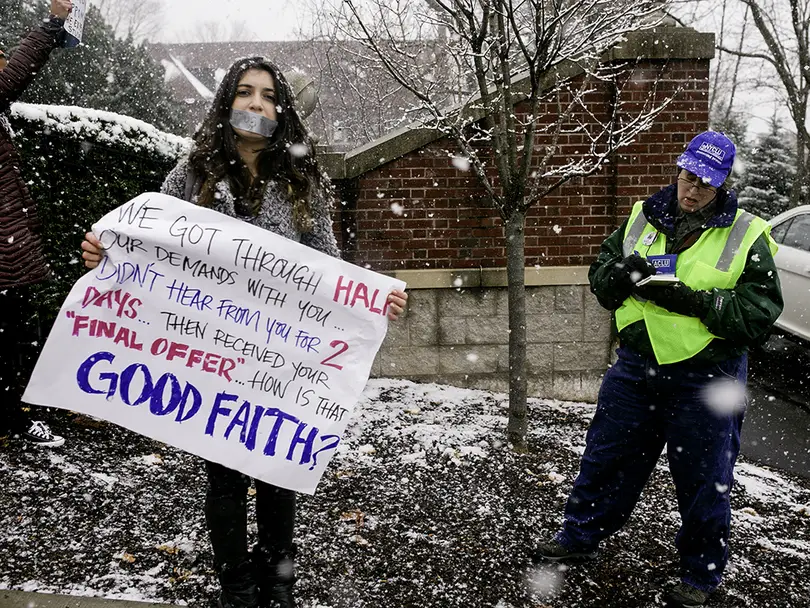Administrators reflect on sit-in, hope to improve communication in the future
For 18 days, students sat in the lobby of Crouse-Hinds Hall, demanding change.
They sat through weekends and they sat as the weather changed from sunny to snowy.
And many Syracuse University administrators had never seen anything quite like it.
“I think all of us certainly interact with students around particular issues over long periods of time,” said Vice Chancellor and Provost Eric Spina. “At least for me this is the first time at Syracuse that we’ve had a sit-in.”
On Nov. 3, following the Diversity and Transparency Rally on the Quad, about 50 students marched to the lobby of Crouse-Hinds, the university’s administration building, with a 43-page grievances and demands document. That night, they met with administrators to discuss the document and 40 students were allowed to stay overnight in the building.
For the next 17 days, the students — members of THE General Body — met with administrators, including Chancellor Kent Syverud, in an effort to come to an agreement over the group’s demands. On Nov. 20, the 18th day of the sit-in, protesters left the building.
During the nearly three weeks that protesters remained in Crouse-Hinds, administrators spent time balancing their day-to-day responsibilities with a sudden need to negotiate with the protesters. For some administrators, that meant learning about new issues on campus, while for others it meant completely reprioritizing their daily schedule.
Bea Gonzalez, Dean of University College, was appointed by Syverud to serve as the liaison between the chancellor and THE General Body. For Gonzalez, working with the protesters was “a monumental time management task.”
“Every day I reprioritized what I needed to accomplish that day based on the work that had to be accomplished with THE General Body,” she said.
Department of Public Safety Chief Tony Callisto said in his 33 years of experience, he’d dealt with protesters many times but never for the length of the sit-in. However, he called the 18 days “uneventful,” saying nobody was hurt and both DPS and the protesters maintained a respectful atmosphere.
But the fact that the sit-in spanned nearly three weeks meant making logistical adjustments, Callisto said. Officers had to be scheduled to be in Crouse-Hinds 24 hours a day, in addition to their regular shifts. That included allowing for scheduled breaks and meal times. And those scheduling changes came at a price.
After the sit-in ended, officers had participated in nearly 1,800 hours of extra time on the job, Callisto said.
“This kind of event is expensive,” he said. “We’re thankful that we’re able to move on and get the situation normal for DPS.”
And while administrators are able to move on as well, they will still work on issues raised by the sit-in and take into account lessons learned since the time the protest started.
Rebecca Reed Kantrowitz, dean of student affairs, met with members of THE General Body multiple times during the sit-in. She said at first, there were many issues brought forward, some of which were new to her. The sheer number of issues discussed in the demands document brought another issue to light for Kantrowitz.
“One thing for me that I realized that I think we all realized is there’s so much going on right now in this institution that the communication piece for us is really critical,” she said.
For example, some concerns raised by protesters were already being worked on, but Kantrowitz said the administration realized it needs to improve communication when that is the case.
Spina echoed that idea, using the university’s mission and vision statement as an example. He said this year was the first time in SU’s history that the proposed statement was put on the school’s website, and the SU community was asked to give input. Spina said he thought the strategic planning steering committee had communicated that opportunity, but later found many students never knew the group was asking for input.
But while there were struggles and teachable moments throughout the sit-in, administrators say progress was made with the protesters on key issues and that won’t change just because the sit-in has ended.
Gonzalez said the administration is “moving on all the things we said we were going to move on,” and maintaining commitments and timelines that were established during the negotiation process. But, she did say that some of the things protesters were requesting will take more time to achieve.
“Some of the things THE General Body is asking are long-term cultural shifts at an institution and they’re not going to be accomplished in the next semester,” she said.
Spina added that while the 18-day sit-in was a learning experience in which significant progress was made, the priority throughout was to focus on the students.
“This isn’t some faceless, nameless opposition,” he said. “We like to interact with students and like to help them achieve their goals in life. I think the most important thing to us from the beginning is that these are our students.”
Published on November 30, 2014 at 11:57 pm
Contact Brett: [email protected] | @Brett_Samuels27






